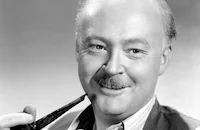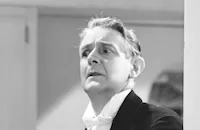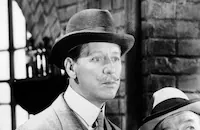The Lone Wolf Spy Hunt

Brief Synopsis
Cast & Crew
Peter Godfrey
Warren William
Ida Lupino
Rita Hayworth
Virginia Weidler
Ralph Morgan
Film Details
Technical Specs

Synopsis
After retiring from the wrong side of the law, ex-jewel thief Michael Lanyard, known as The Lone Wolf, settles down to a legitimate job in Washington, D.C. One evening, Lanyard is abducted by gunmen and taken to the leader of an espionage ring, Spiro, who offers Lanyard $10,000 to pick the War Department's safe and steal the plans for a new anti-aircraft gun. When Lanyard refuses to accept the assignment, Spiro releases him, but not before stealing several cigarettes from him. The following day, the War Department safe is robbed and Lanyard's half-smoked cigarettes are found at the scene of the crime. As a result, Inspector Thomas, Lanyard's nemesis, suspects the former jewel thief of the crime and pays him a visit. After giving the inspector his alibi, Lanyard leaves for a cocktail party with Val Carson, the senator's daughter, who is determined to marry Lanyard. Soon after arriving at the bar, Lanyard is approached by Karen, one of Spiro's operatives, and lured to Spiro's house, where he is informed that the spies made off with only half of the plans that were supposed to have been stolen, and that he will be expected to retrieve the remaining plans, which are located at the home of an inventor named Palmer. Lanyard is led forcibly to Palmer's house, where he manages to elude his captors long enough to remove the real plans from the safe and replace them with a baby carriage. After Spiro's men find the carriage, Lanyard turns the real plans over to Val's father and goes to Spiro's house to recover the remaining plans. Later, when Karen fails in her attempt to buy the secret plans from Lanyard, she drives away. Unknown to Karen, however, Lanyard's daughter Patricia, an amateur detective, lies hidden in her car. While trailing Spiro, Lanyard is recaptured by the master spy, but is saved by Patricia, who creates a diversion by stealing the plans once again. A car chase ensues and ends when the police arrive and arrest the spies.

Director

Peter Godfrey
Cast

Warren William

Ida Lupino

Rita Hayworth

Virginia Weidler

Ralph Morgan
Tom Dugan

Don Beddoe

Leonard Carey
Ben Welden
Brandon Tynan
Helen Lynd

Irving Bacon
Marek Windheim
Jack Norton
Dick Elliott
Alec Craig
Dick Curtis
Lou Davis
John Tyrrell
Marc Lawrence
Stanley Brown
Beatrice Curtis
Lola Jensen

James Craig
Tony Hughes
Bud Jamison
Eddie Laughton
Forbes Murray
James Blaine
Frank Baker
Russ Clark
Landers Stevens

Lee Phelps
Vernon Dent

Jim Millican
Eddie Hearn
Eddie Cobb
Jack Hill
George Denormand
Ed Brandenberg
Dick Jensen
Ed Randolph
Lorna Gray
Eddie Fetherston
Crew
Lionel Banks
Art Black
Carmelita Bonam
Cliff Broughton
Lodge Cunningham
Ellen Duffy
Kalloch
Jonathan Latimer
Otto Meyer
Allen G. Siegler
Joseph Sistrom
Joe Smith
M. W. Stoloff

Film Details
Technical Specs

Articles
The Lone Wolf Spy Hunt
It's true that there were an awful lot of gentleman-detective franchises in production at this time in Hollywood. MGM's Thin Man series was the cream of the crop, while on the B level, RKO had The Saint (and would soon have The Falcon), Warners and Paramount were producing Philo Vance, and Columbia had The Lone Wolf. (And let's not forget all the other detective series like Sherlock Holmes, Charlie Chan, Ellery Queen, Mr. Moto and Mr. Wong.)
The Lone Wolf character dates back to 1914, when author Louis Joseph Vance invented him for a series of books. "The Lone Wolf" is the moniker given to debonair jewel thief Michael Lanyard, and as written by Vance he was a charming European rogue with a James Bond-like weakness for dames. From the silent era to the late 1940s, the character was the basis for over 20 pictures and was played by a variety of actors. It also eventually became a radio series and a TV show. In 1935 Columbia Pictures re-booted the franchise; The Lone Wolf Spy Hunt was the third of this new series and the first to star Warren William, who did nine titles in all.
In The Lone Wolf Spy Hunt, Lanyard is now a reformed gentleman thief. In fact, he gives up his thieving ways at the outset, only to soon be framed for the theft of some military secrets. The story had been previously filmed as The Lone Wolf's Daughter (1919 and 1929), though the script was changed significantly for this version. Like the other films in this round of the series, The Lone Wolf Spy Hunt mixes comedy and suspense very nicely, and entertains for its brief running time. Helping matters is an exceptionally good supporting cast including Ida Lupino, Rita Hayworth and Ralph Morgan.
The film was somewhat significant for both Lupino's and Hayworth's careers. Since having parted ways with Paramount, Lupino wasn't getting work. Her fiancé, Louis Hayward, asked his own agent to represent her, and he took her on, immediately setting up a meeting with Columbia chief Harry Cohn. "You're not beautiful, Ida, but you've got a funny little pan," Cohn told her crudely. Lupino signed a two-film deal and the first title was The Lone Wolf Spy Hunt - just the kind of B-movie she had grown tired of at Paramount. But this time, she was happy just to be working. In the middle of production, 20-year-old Lupino and 29-year-old Hayward were married. They reported back to work the next day, and over the following weekend had a honeymoon in Malibu.
As for 20-year-old Rita Hayworth, this was the first movie for which she was fitted with custom-designed dresses. (On previous films, she had been clothed with wardrobe department cast-offs). She also, for the first time, was given her own stand-in.
Producer: Joseph Sistrom
Director: Peter Godfrey
Screenplay: Jonathan Latimer, Louis Joseph Vance (novel)
Cinematography: Allen G. Siegler
Film Editing: Otto Meyer
Art Direction: Lionel Banks, Jerome Pycha, Jr.
Music: Joseph Nussbaum
Cast: Warren William (Michael Lanyard), Ida Lupino (Val Carson), Rita Hayworth (Karen), Virginia Weidler (Patricia Lanyard), Ralph Morgan (Spiro Gregory), Tom Dugan (Police Sergeant Devan).
BW-67m.
by Jeremy Arnold

The Lone Wolf Spy Hunt
Quotes
Trivia
Notes
Working titles for this film were The Lone Wolf's Daughter and The Lone Wolf. Modern sources indicate that although the script for Columbia's 1929 film The Lone Wolf's Daughter (see AFI Catalog of Feature Films, 1921-30; F2.3165) was used as the basis for this film, the story was changed completely following John Latimer's assignment to the screenplay. Louis Joseph Vance's "The Lone Wolf" stories and novels provided the basis for at least twenty-four films made between 1917 and 1949. Following the 1938 release of its The Lone Wolf in Paris, Columbia committed itself to making a series of "The Lone Wolf" films with Warren William starring as the gentleman sleuth, and initiated the series with this film. Following the release of The Lone Wolf Spy Hunt, William starred in eight "The Lone Wolf" pictures, until 1946, when Gerald Mohr took over the role in The Notorious Lone Wolf. The first film based on the "The Lone Wolf" novels was the 1917 Herbert Brenon production The Lone Wolf, which featured Bert Lytell as detective "Michael Lanyard" (see AFI Catalog of Feature Films, 1911-20; F1.2583). Other films based on the "The Lone Wolf" novels, which were not part of Columbia's series starring Warren William, include: the 1924 independent film The Lone Wolf, directed by S. E. V. Taylor and starring Dorothy Dalton and Jack Holt (see AFI Catalog of Feature Films, 1921-30; F2.3163); the 1935 Columbia film The Lone Wolf Returns; and The Lone Wolf and the Lady, directed by John Hoffman and starring Ron Randell. In April 1954, the first episode of the The Lone Wolf television series (also known as Streets of Danger) had its non-network television premiere. The half-hour show was produced by Jack Gross and Philip Krasne and starred Louis Hayward as "Michael Lanyard." This film marked British stage director Peter Godfrey's first screen effort. Modern sources note that the name of "Lanyard's" valet, known in previous "The Lone Wolf" films as "Jenkins," was changed to "Jameson" for this and other films. For a list of additional titles in the "The Lone Wolf" series, consult the Series Index.














